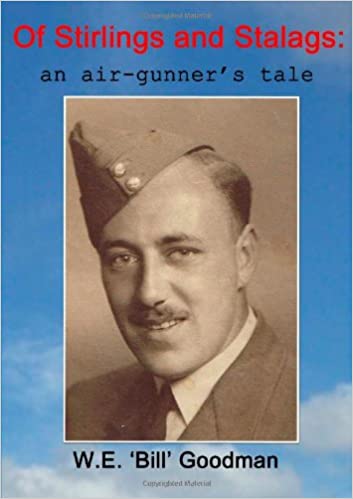
Service number- 1263380 A/G and W/Op – 7 Squadron, Oakington, Cambridgeshire
Extract taken from his book- ‘Of Stirlings and Stalags: an air-gunner’s tale’
“…new electronic navigational aid, they were being installed in aircraft. Named ‘Gee’, it consisted of a cathode ray tube mounted above the navigator’s table which looked like a television screen and showed grids which, when read, would allow the plane’s position to be calculated with accuracy. It received signals from ground stations in England which transmitted those grids. It was mounted down in the bomb aimer’s compartment. Top secret maps were issued from which those grids could be interpreted, and so they should not fall into enemy hands they should be put into a long tube adjacent to the observer’s seat. Those three installations contained explosive charges, as was a device known as IFF (Identification, friend or foe), mounted towards the rear. IFF indicated to the people manning the radar installations which tracked incoming aircraft that a particular plane was not a ‘hostile’. It was the duty of the wireless operator manning the front turret to disarm the charges by unscrewing and withdrawing them.
On another trip I was in the front turret and it was our task again to get there early. It had been quite a dicey trip as we had been coned by searchlights. With these the main searchlight using sophisticated gear locked onto their target and a number of other searchlights swung onto it. That main searchlight was very intense and with a bluish tint to it. It was absolutely blinding, even with the visor down and the goggles on the pilot had to really throw the plane around the skies in order to escape from it. It was usually linked to anti-aircraft batteries and, in that light, we were sitting targets. Buck weaved, dived and climbed and we eventually freed ourselves from the cone but not before we had suffered considerable flak (anti-aircraft) damage. Even so we managed to reach the target on time and bombed according to schedule. We got back in good time, and were the first to reach Oakington. The Station Commander drove out to greet us. Jack had left his turret as we taxied round to our dispersal point and I commenced the task of disarming the secret equipment. The first was the receiving equipment in the bomb aimer’s compartment. The explosive charge was held in place by a collar with a long, fine thread which required goodness knows how many turns. When the thread ended the connection was simply pulled out from the charge. I pulled it out and as I did so there was a blinding flash from within the casing. Its joints bulged outwards and the flash could be seen through the ventilation louvres of the case.
These were the last things I saw.
Later I learnt that all the detonators had gone off simultaneously, even the one in IFF, which was immediately opposite the rear door. Jack had opened the door and dropped down the steps and the Station Commander was just mounting them to discuss the trip when the IFF detonator exploded right in front of him. He fell backwards and drove off to get help. I was led, still blind, through the aircraft and into the ambulance which the Station Commander had brought. These were some of the worst moments of my life. I did not know what would happen; would I be blinded for life, walking round sightless and with a white stick? I could imagine nothing worse, and my thoughts immediately went to Monica and how glad I was not to be involving her to a life of drudgery with a helpless husband and was glad I had not declared my feelings. I was still conscious, of course, and spent the night in Station Sick Quarters while the surgeon extracted something in the order of seventeen pieces of glass from my eyes and face.
In 1942 transistors were still several years into the future. They replaced valves which were pressurised glass tubes, rather like electric lamps, with all manner of radio equipment sealed inside, which, together with minute particles of glass would explode outwards if burst. Happily I suffered no lasting damage to my eyesight.
Many years later there was a sequel to this event. At that time I was a constable doing a night patrol when I was visited by a Sergeant, newly on the streets after several years in the quietness of H.Q. and put out to gain some street experience. Amongst my medal ribbons the Air Crew Europe marked me out as having been an operational flyer in the earlier days of the war. The sergeant asked me about my service. When it came out that I had been on 7 Squadron and when it transpired he had also been in the RAF with the trade of radar mechanic who had worked on Gee…suddenly my name rang a bell in his mind and he asked whether I had blown up Gee equipment. Apparently my episode was the first such occurrence and the hierarchy was most upset to lose such valuable equipment. They had considered a Court Martial for carelessly damaging such vital equipment, but the intention was cancelled when a detailed inspection of the plane’s electrical circuitry was found to have been damaged during enemy action, which had resulted in the explosions (all the charges were connected to the same switch in the cockpit and it was that which detonated all at the same time).
Sent by Gill Chesney-Green:
My father’s book opened my eyes to just what he had done in the war and what he had suffered whilst in captivity in various Luft Stalags. His efforts, along with many others in Bomber Command, showed me just how brave, and yet how young, these men and women were.